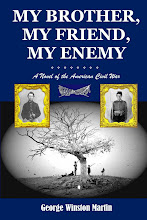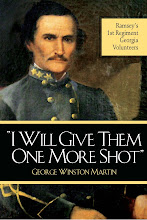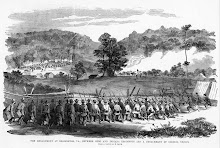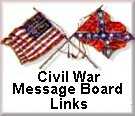The Walker Light Infantry, which would become Company “I” of the First Georgia, was constituted in early 1861 by combining two companies of so-called “minute men” in Augusta. The company was commanded by Captain Samuel H. Crump, and was issued “Mississippi” style rifles, .54 caliber. On March 23, 1861, the company received a new banner. The presentation was described in the Augusta Daily Constitutionalist the following day:
“The Walker Light Infantry, Capt. S. H. Crump, paraded yesterday afternoon. At four o’clock, the company marched to the City Hall, where a beautiful banner, “the work of fair hands,” was presented to them. JOHN B. WEEMS, of the Southern Republic, made the presentation, accompanying it with some patriotic and appropriate remarks.
Lieut. W. H. WHEELER, of the Walker Light Infantry, made the response in a very neat and totally appropriate little speech.
A detachment of the Washington Artillery fired a salute of seven guns on the river bank for the flag. The juvenile company, the Richmond Guards, who were on the balcony of the City Hall during the presentation, gave the banner three cheers.
The [field] of white ground, having the coat of arms of Georgia on one side, with the motto: “Dear our country; our liberty dearer.” On the other side is an uplifted arm grasping a sword. The flag is trimmed with a neat fringe, and is altogether creditable to the fair donors whose work it is; and they have entrusted it to worthy hands.
After the presentation, the company paraded for some time in Broad Street.”
The flag’s description is a little vague, not giving the precise layout of the state coat of arms and words. I’ve come up with a couple of variations to show what it may have looked like:
The obverse may have looked something like this:
Sunday, November 28, 2010
Thursday, November 25, 2010
Happy Thanksgiving
I would like to wish one and all a safe and Happy Thanksgiving! My best wishes go out to you and your families. And a special greeting to all of our men and women in uniform this holiday - thank you for your service.
George W. Martin
George W. Martin
Thursday, November 18, 2010
150 Years Ago
After Abraham Lincoln's election on November 6, 1860, communities across Georgia and the South intensified their recruiting efforts in anticipation of possible conflict. Existing militia units filled with volunteers, and new units popped up throughout the state.
Not every unit was having an easy time filling its ranks. In the town of Sandersville, members of the Washington Rifles were dismayed that their company was not yet at full strength. Deciding that a good scolding was in order, a committee drafted a letter to the populace, which appeared in the November 20 edition of the Sandersville Central Georgian:
To the People of Washington County:
The undersigned were appointed a committee to address you in behalf of the Washington Rifles. As the Rifles stand alone, it would be naturally supposed that out of a regiment which would muster more than a thousand efficient men, at least one in ten would lead them to sustain one volunteer corps. The result, however, does not justify this opinion; and the Washington Rifles as a Company, has the mortification of seeing in other counties large and flourishing volunteer companies—while old Washington can scarcely muster fifty men willing efficiently to serve the State.
While we would not impugn the patriotism of the old, or the gallantry and bravery of the young, need, hundreds would be found willing to serve, of what use in a time of war would be an undrilled militia? All experience has shown, that a course of military training is absolutely necessary to perfect the soldier, and although the universal use of fire arms—to which our youth from infancy are accustomed—makes them, individually, formidable, and perhaps invincible behind entrenchments. Yet in the open field, it is well known that the disciplined valor of a few, can accomplish more than that of four times their number of inexperienced recruits. To render efficient service to the country, then, the soldier must be trained—he must be drilled in the use of his weapons—trained to understand his duty, and how best to perform it. This is not the work of a day, though much may be accomplished in a short time. Usually, however, months of patient, daily training are found necessary to perfect the new recruit in company and regimental drill, without which he is unreliable in the field.
In view of the unsettled condition of our country, and of the gathering storm, which may burst in rain upon our heads, does not the voice of patriotism call upon all to prepare for the conflict—and shall Georgia call and Washington not answer? or shall our rights demand our service in the field, and we be unprepared for the conflict? Patriotism and honor alike forbid.
In behalf of our corps, we invoke the aid of our young countrymen—we invite you to join our ranks to aid us by your co-operation—to you your country looks for protection, to the youthful, the gallant, the brave! Will you be laggard? Will you shrink from the conflict? Will you prefer inglorious ease? Shall your country call in vain? Sons of Revolutionary sires, shall your country’s call be unheeded?
To another class of our fellow-citizens we address ourselves. To you who, having a large interest at stake at home, are disqualified for the field—we appeal to you to assist. There are young men who would enlist, but are unable to uniform themselves. It is your duty to assist them. Let each one of you uniform a young man of character, and the Washington Rifles will soon number a hundred or more efficient men, and be an honor to the county, whose name it bears, and whose interest it will ever be willing to protect and defend.
When we consider the means which are employed to disturb the peace of the South; when we see a religious fanaticism, even the most relentless, which would plunge our country into all the horrors of a servile war, deluging our peaceful land with blood, and resulting in the destruction of a race now peaceful, contented and happy, and upon whose labor the happiness of millions of the human race depend, self interest as well as patriotism demands that we be prepared to protect ourselves, and be prepared to meet and repel aggression at the threshold. Your fellow citizens,
J. R. SMITH
B. D. EVANS,
Committee.
Not every unit was having an easy time filling its ranks. In the town of Sandersville, members of the Washington Rifles were dismayed that their company was not yet at full strength. Deciding that a good scolding was in order, a committee drafted a letter to the populace, which appeared in the November 20 edition of the Sandersville Central Georgian:
To the People of Washington County:
The undersigned were appointed a committee to address you in behalf of the Washington Rifles. As the Rifles stand alone, it would be naturally supposed that out of a regiment which would muster more than a thousand efficient men, at least one in ten would lead them to sustain one volunteer corps. The result, however, does not justify this opinion; and the Washington Rifles as a Company, has the mortification of seeing in other counties large and flourishing volunteer companies—while old Washington can scarcely muster fifty men willing efficiently to serve the State.
While we would not impugn the patriotism of the old, or the gallantry and bravery of the young, need, hundreds would be found willing to serve, of what use in a time of war would be an undrilled militia? All experience has shown, that a course of military training is absolutely necessary to perfect the soldier, and although the universal use of fire arms—to which our youth from infancy are accustomed—makes them, individually, formidable, and perhaps invincible behind entrenchments. Yet in the open field, it is well known that the disciplined valor of a few, can accomplish more than that of four times their number of inexperienced recruits. To render efficient service to the country, then, the soldier must be trained—he must be drilled in the use of his weapons—trained to understand his duty, and how best to perform it. This is not the work of a day, though much may be accomplished in a short time. Usually, however, months of patient, daily training are found necessary to perfect the new recruit in company and regimental drill, without which he is unreliable in the field.
In view of the unsettled condition of our country, and of the gathering storm, which may burst in rain upon our heads, does not the voice of patriotism call upon all to prepare for the conflict—and shall Georgia call and Washington not answer? or shall our rights demand our service in the field, and we be unprepared for the conflict? Patriotism and honor alike forbid.
In behalf of our corps, we invoke the aid of our young countrymen—we invite you to join our ranks to aid us by your co-operation—to you your country looks for protection, to the youthful, the gallant, the brave! Will you be laggard? Will you shrink from the conflict? Will you prefer inglorious ease? Shall your country call in vain? Sons of Revolutionary sires, shall your country’s call be unheeded?
To another class of our fellow-citizens we address ourselves. To you who, having a large interest at stake at home, are disqualified for the field—we appeal to you to assist. There are young men who would enlist, but are unable to uniform themselves. It is your duty to assist them. Let each one of you uniform a young man of character, and the Washington Rifles will soon number a hundred or more efficient men, and be an honor to the county, whose name it bears, and whose interest it will ever be willing to protect and defend.
When we consider the means which are employed to disturb the peace of the South; when we see a religious fanaticism, even the most relentless, which would plunge our country into all the horrors of a servile war, deluging our peaceful land with blood, and resulting in the destruction of a race now peaceful, contented and happy, and upon whose labor the happiness of millions of the human race depend, self interest as well as patriotism demands that we be prepared to protect ourselves, and be prepared to meet and repel aggression at the threshold. Your fellow citizens,
J. R. SMITH
B. D. EVANS,
Committee.
Wednesday, November 3, 2010
A Face of the Civil War
A member of the First Georgia has been honored in Virginia. William S. Askew of the Newnan Guards, Company A of the First, appears on the new logo for the Manassas 150th Civil War Commemoration. The artist, Allan Guy of Allan Guy Design and Illustration of Manassas, Virginia, searched through the extensive holdings of the Library of Congress looking for just the right image of an early war soldier. When he came across Askew’s photograph, Guy knew he had the one he was looking for. Even though Askew did not serve at First or Second Manassas, Allan was taken by the “haunted” look in Askew’s eyes, and felt that Askew would represent well all the young, impressionable and eager young men who marched off to war in 1861. "I searched through a lot of images -- men and women -- with compelling faces, but this boy's eyes just shot out at you. This kid has the combination of age and eyes that are most direct," Allan explained in an interview. "A face like that is beyond comparison to even a period object or historic house. I wanted to make sure it had warmth because all too often history seems dead and gone."
Allan was also careful to use the appropriate First National flag in his illustration, instead of using the better known Southern Cross battleflag.*
The original image is displayed right. Askew strikes an suitably war-like pose as he holds his musket at attention, brandishing a brace of pistols in his belt. The private enlisted in the Newnan Guards on May 7, 1861, while the regiment was in Pensacola. During the retreat of the First and the Army of the Northwest from Laurel Hill in July, Askew was captured by Federal troops, but was able to escape and return to his regiment. In bad health as a result of his ordeal, Askew was discharged from the Newnan Guards on August 21. He later served in the 16th Georgia Cavalry Battalion, only to be captured again, and was imprisoned in Camp Morton, Indiana, until the end of the war.
I think Allan did a superb job with the logo.
-----------------------------------------
*Appropriate in that the Southern Cross did not exist until after the Battle of First Manassas (or Bull Run).
Allan was also careful to use the appropriate First National flag in his illustration, instead of using the better known Southern Cross battleflag.*
The original image is displayed right. Askew strikes an suitably war-like pose as he holds his musket at attention, brandishing a brace of pistols in his belt. The private enlisted in the Newnan Guards on May 7, 1861, while the regiment was in Pensacola. During the retreat of the First and the Army of the Northwest from Laurel Hill in July, Askew was captured by Federal troops, but was able to escape and return to his regiment. In bad health as a result of his ordeal, Askew was discharged from the Newnan Guards on August 21. He later served in the 16th Georgia Cavalry Battalion, only to be captured again, and was imprisoned in Camp Morton, Indiana, until the end of the war.
I think Allan did a superb job with the logo.
-----------------------------------------
*Appropriate in that the Southern Cross did not exist until after the Battle of First Manassas (or Bull Run).
Labels:
Newnan Guards,
Sesquicentennial,
Soldiers
Subscribe to:
Posts (Atom)
.jpg)














